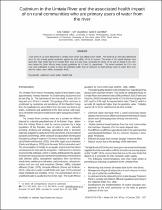 ResearchSpace
ResearchSpace
Cadmium in the Umtata River and the associated health impact of on rural communities who are primary users of water from the river
JavaScript is disabled for your browser. Some features of this site may not work without it.
- ResearchSpace
- →
- Research Publications/Outputs
- →
- Journal Articles
- →
- View Item
| dc.contributor.author |
Fatoki, OS

|
en_US |
| dc.contributor.author |
Awofolu, OR

|
en_US |
| dc.contributor.author |
Genthe, Bettina

|
en_US |
| dc.date.accessioned | 2007-03-26T11:26:03Z | en_US |
| dc.date.accessioned | 2007-06-07T10:08:56Z | |
| dc.date.available | 2007-03-26T11:26:03Z | en_US |
| dc.date.available | 2007-06-07T10:08:56Z | |
| dc.date.copyright | en_US | |
| dc.date.issued | 2004-10 | en_US |
| dc.identifier.citation | Fatoki, OS, Awofolu, OR and Genthe, B. 2004. Cadmium in the Umtata River and the associated health impact of on rural communities who are primary users of water from the river. Water SA, vol. 30(4), pp 507-513 | en_US |
| dc.identifier.issn | 0378-4738 | en_US |
| dc.identifier.uri | http://hdl.handle.net/10204/2051 | en_US |
| dc.identifier.uri | http://hdl.handle.net/10204/2051 | |
| dc.description.abstract | Trace levels of Cd were determined in Umata River which may affect human health. The levels of Zn were also determined since Zn can provide partial protection against the toxic effect of Cd in humans. The levels of Cd varied between trace and 0.007 mg/l while that of Zn ranged from trace to 0.019 mg/l. Generally, the levels of Cd and Zn found in the river were below the South African water quality guidelines for Cd and Zn, respectively. The hazard quotients for Cd in the river were calculated in order to show the potential health risks of cadmium to local primary users of water from river and the values within acceptable limits. | en_US |
| dc.format.extent | 106712 bytes | en_US |
| dc.format.mimetype | application/pdf | en_US |
| dc.language.iso | en | en_US |
| dc.publisher | Water Research Commission | en_US |
| dc.rights | Copyright: 2004 Water Research Commission | en_US |
| dc.source | en_US | |
| dc.subject | Cadmium | en_US |
| dc.subject | Umtata river | en_US |
| dc.subject | River water | en_US |
| dc.subject | CD levels | en_US |
| dc.subject | ZN levels | en_US |
| dc.subject | Cadmium health risks | en_US |
| dc.subject | Water resources | en_US |
| dc.title | Cadmium in the Umtata River and the associated health impact of on rural communities who are primary users of water from the river | en_US |
| dc.type | Article | en_US |
| dc.identifier.apacitation | Fatoki, O., Awofolu, O., & Genthe, B. (2004). Cadmium in the Umtata River and the associated health impact of on rural communities who are primary users of water from the river. http://hdl.handle.net/10204/2051 | en_ZA |
| dc.identifier.chicagocitation | Fatoki, OS, OR Awofolu, and Bettina Genthe "Cadmium in the Umtata River and the associated health impact of on rural communities who are primary users of water from the river." (2004) http://hdl.handle.net/10204/2051 | en_ZA |
| dc.identifier.vancouvercitation | Fatoki O, Awofolu O, Genthe B. Cadmium in the Umtata River and the associated health impact of on rural communities who are primary users of water from the river. 2004; http://hdl.handle.net/10204/2051. | en_ZA |
| dc.identifier.ris | TY - Article AU - Fatoki, OS AU - Awofolu, OR AU - Genthe, Bettina AB - Trace levels of Cd were determined in Umata River which may affect human health. The levels of Zn were also determined since Zn can provide partial protection against the toxic effect of Cd in humans. The levels of Cd varied between trace and 0.007 mg/l while that of Zn ranged from trace to 0.019 mg/l. Generally, the levels of Cd and Zn found in the river were below the South African water quality guidelines for Cd and Zn, respectively. The hazard quotients for Cd in the river were calculated in order to show the potential health risks of cadmium to local primary users of water from river and the values within acceptable limits. DA - 2004-10 DB - ResearchSpace DP - CSIR KW - Cadmium KW - Umtata river KW - River water KW - CD levels KW - ZN levels KW - Cadmium health risks KW - Water resources LK - https://researchspace.csir.co.za PY - 2004 SM - 0378-4738 T1 - Cadmium in the Umtata River and the associated health impact of on rural communities who are primary users of water from the river TI - Cadmium in the Umtata River and the associated health impact of on rural communities who are primary users of water from the river UR - http://hdl.handle.net/10204/2051 ER - | en_ZA |





